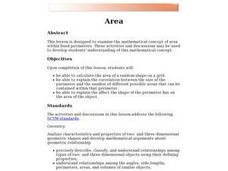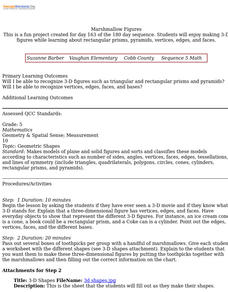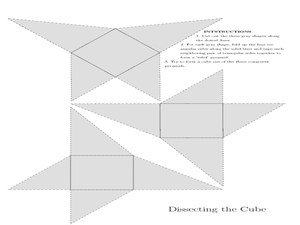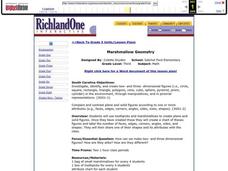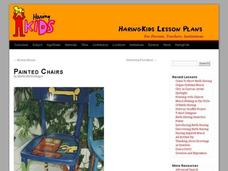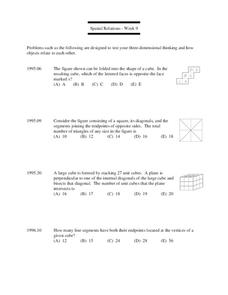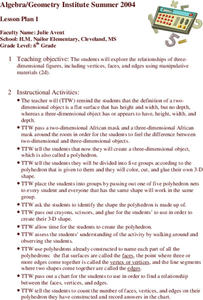Pennsylvania Department of Education
Making Cubes
Third graders explore vocabulary associated with three dimensional figures. In this transformations lesson, 3rd graders create two dimensional nets for three dimensional figures. Students become familiar with describing two...
Curated OER
Regular Polyhedra
Tenth graders investigate the history of geometry and its different shapes. In this geometry instructional activity, 10th graders practice seeing three dimensional shapes and explain why there are only five polyhedra. They relate all the...
Curated OER
Connecting With Coordinates
Play a coordinates game to encourage collaborative learning and grid use! Learners plot points on grids and play a game that challenges them to locate a specific point on a coordinate grid by using horizontal and vertical movements.
Curated OER
Area Applet
Elementary math classes calculate the area of a shape and explain the correlation between the size of the perimeter and the areas that can be contained within that perimeter. They also explain the effect the shape of the perimeter has on...
Curated OER
Using 2 and 3 Dimensional Geometric Shapes
Pupils explore geometry by participating in a shape identification activity. In this figure dimensions instructional activity, students identify the difference between 2 and 3 dimensional shapes by their vertices and faces. Pupils...
Curated OER
3-D Figures Part 2
Students work with three dimensional objects. In this geometry lesson, students examine models of spheres, cones, cubes, prisms, and pyramids, and identify them by their edges, vertices, and faces.
Hawaiʻi State Department of Education
Symmetrical Objects
In order to better understand how to locate a plane of symmetry in 3-dimensional objects, learners create a dance. The class reviews dance and math symmetry, then they practice making symmetrical shapes and movements with a partner....
Curated OER
Marshmallow Figures
Students enjoy making 3-D figures while learning about rectangular prisms, pyramids, vertices, edges, and faces. After a lecture/demo, students use marshmallows, toothpicks and a worksheet imbedded in this lesson to create 3 dimensional...
Mathed Up!
Nets, Plans, and Elevations
A dimensional resource teaches viewers to recognize 2-D views of 3-D objects and how to match nets with their 3-D figures. Individuals draw different views of three-dimensional objects including views from the front, side...
Curated OER
Dissecting the Cube
Students investigate the volume of cones. In this geometry lesson, students define the formula to find the volume of cones. They define the concept of having to dissect a three dimensional figure and find the volume.
American Institute of Physics
African American Inventors in History
A two-part lesson plan introduces young historians to the work of famous African American inventors. Groups first research and develop a presentation of an inventor that includes biographical information and information about one of...
Curated OER
Halves and Fourths
Young mathematicians may not love fractions, but do they love sandwiches? How about cake? Use this visual fractions activity to represent fractions in a relatable way. Scholars start by coloring segmented shapes to indicate halves and...
National Security Agency
Awesome Area - Geometry and Measurement
Break out those math manipulatives, it's time to teach about area! Capturing the engagement of young mathematicians, this three-instructional activity series supports children with learning how to measure the area of squares,...
California Academy of Science
Fish Forms
I've said it before, and I'll say it again, you can add art to any lesson! While little learners are discovering why fish have specific body parts such as, scales, fins, and gills, they start making three-dimensional fish forms. Children...
Curated OER
Transformations and Translations in Geometry
In this transformations and translations in Geometry worksheet, learners use geometric shapes and grids to translate six transformations in each of two activities.
Teach Engineering
Circuits and Magnetic Fields
Have your class use compasses to try to find the magnetic field around an electric current. Groups use the same technique to visualize magnetic fields as they did in the second activity in the series, but this time, the field is...
Curated OER
Marshmallow Geometry
Third graders create 2D and 3D shapes using marshmallows and toothpicks. In this geometry lesson plan, 3rd graders create their shapes and document the number of faces, edges, corners, angles, and sides. They share one shape and its...
Curated OER
Landscape Book
Students create a three-dimensional book about landscapes. They must show their understanding of shape, color and balance.
Curated OER
Expressing Emotions Through Art Lesson 3: Everybody Works Together
Students examine works of art that convey the idea of working together and analyze how artists use foreground, middle ground, and background. They use two-and three-dimensional materials to create a work of art.
Curated OER
Painted Chairs
Students evaluate visual arts by creating furniture designs. For this three dimensional art lesson, students utilize the web to examine different artist renderings of furniture, sculpture and architecture. Students utilize paint to...
Curated OER
Spatial Relations - Week 9
In this spatial relations worksheet, students solve three-dimensional problems. They find the total number of triangles in a given figure, the number of line segments that endpoints and use integer points to solve two problems. This...
Curated OER
Wonders of the World
Third graders examine two-dimensional objects and create a 3-D image of the object. They make models of the Taj Mahal and buildings in Delhi.
Curated OER
Tessellation Project
Fifth graders will be predicting and describing the results of sliding, flipping, and turning two-dimensional shapes. They will also understand patterns so they can describe, extend, and make generalizations about geometric and numeric...
Curated OER
Three-Dimensional Figures
Sixth graders explore three-dimensional objects. In groups, they create and decorate their own polyhedron design. After identifying the faces, vertices, and edges of the polyhedron, 6th graders determine a relationship between the...



